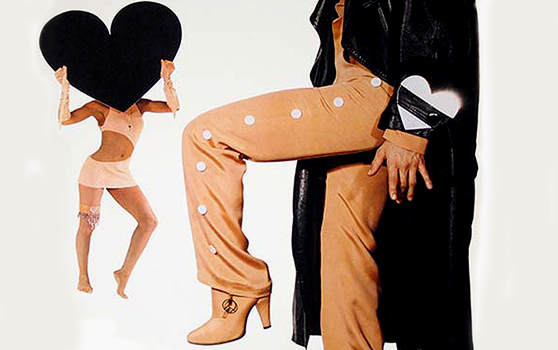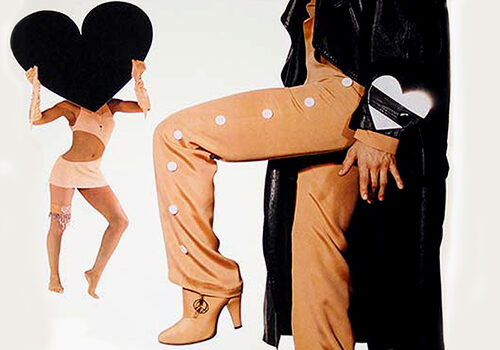I’ve only ever committed one fashion crime: buying an item of peach-coloured clothing. Prince Rogers Nelson is to blame for this gross misdemeanour. It was in the early summer of 1987 and I’d just acquired tickets for his forthcoming show at Wembley Stadium. The tickets contained a simple request: to wear something peach or black to the concert. At the time, my 17-year-old self had a wardrobe full of black jeans and black Cure t-shirts as I flirted with the idea of being a goth to try and impress the prettiest girls at my school. However, with my Prince addiction at its most fierce, I decided to branch out and purchased a horrendous over-sized, pastel-peach jacket from Stolen From Ivor in Manchester’s Arndale Centre. Tragically, bad weather forced the Wembley gig to be cancelled and the jacket never got a formal outing.
Luckily my obsession with Prince meant I had already seen a sensational show a few weeks earlier in Paris after a coach journey that involved a motorway crash in which I was injured by flying Lionel Richie cassettes. However, in 1987 this level of dedication was normal behavior. Like many, I’d fallen for Prince’s music on 1984’s Purple Rain and had subsequently devoured his back catalogue while amassing a huge collection of his protégé bands’ material (be it the glorious Sheila E or the laughably bad The Family).
By 1987, I felt I was witnessing a truly golden run of creativity; I had loved the psychedelic pop of 1985’s Around The World In A Day and the experimental funk of the following year’s Parade. These albums were being delivered year-on-year; Prince released nine albums in the decade preceding Sign O’ The Times. With a resolute belief that only a stubborn 17-year-old can possess, I also considered this new double album to be Prince’s magnum opus; 16 scintillating tracks which neatly encapsulated his outrageous, chameleonic flair for funk, rock, soul, gospel, rap and downright oddness. Then I thought Sign O’ The Times was the best album of the eighties and, perhaps, the most complete double album in pop history. A quarter of a century later my views haven’t changed much.
Less debatable is the widescreen scope of Sign O’ The Times. It seemed to ooze with the confidence a man completely comfortable with his talent. However, in 1987 life wasn’t completely peachy for Prince. Commercially, sales of subsequent albums were well down on the astonishing 21 million units shifted by Purple Rain – which is, perhaps, why Warner Brothers were a little nervous when Prince initially wanted his 1987 release to be a triple album.
Indeed, Sign O’ The Times was the distillation of several projects during a tempestuous time for Prince. After his second feature film, Under The Cherry Moon, had been rightly panned, simmering tensions had also led him to sack his backing band, The Revolution – but not before he had recorded a series of tracks with them under the project name of the Dream Factory. During late 1986, Prince had also laid down several tracks under the moniker of Camille (in which he sang in a heavily-treated falsetto, as on ‘Housequake’) and these two bodies of work, along with some brand new material were merged into the 22-track leviathan Crystal Ball. When Warner Brothers refused to release a triple album, Prince dropped seven songs and added a brand new one – the album’s weakest track, the Prince-by-numbers ‘U Got The Look’.
Sign O’ The Times was released on 31st March 1987 on his Paisley Park imprint. Having bunked off school to buy his previous three albums on the morning of their release, fate had this time conspired against me. I was returning from a school trip that day and asked my girlfriend at the time to buy the album and "to not listen to it, please." She did the former but not the latter. When I arrived home she announced that Sign O’ The Times was “too long and had too many weird songs.” The relationship didn’t last much longer.
Two of the ‘weird’ songs my soon-to-be-ex was referring to were ‘The Ballad Of Dorothy Parker’ and ‘If I Was Your Girlfriend’. Both would become central to my view that Sign O’ The Times was the period when artistically Prince pushed himself furthest. The former is four minutes of subdued funk and nocturnal keyboards and manages the double whammy of being utterly bizarre and completely brilliant. The gloriously descriptive opening lines of “Dorothy was a waitress on the promenade / She worked the nightshift / Dishwater blonde, tall and fine / She got a lotta tips” précis a bizarre tale in which our hero takes a bath with the ‘Joni-singing’ Ms Parker.
‘If I Was Your Girlfriend’ is even better and perhaps one of Prince’s greatest songs. Over a squidgy keyboard line, and employing the androgynous Camille-style falsetto, the lyric outlines the gender tension inherent within the rules of a relationship. “If I was your girlfriend / Would you remember to tell me all the things you forgot to tell me / When I was you man?”, Prince inquires, before the song rushes into an orgasmic frenzy with him trying to “imagine what silence looks like.” Both tracks took time to unravel their genius, but were a million miles away from the drooling sex-imp personae of so much of Prince’s previous work.
As with many older releases, the vinyl version of Sign O’ The Times makes the most sense. The four sides each became mini-operas in their own right. Side One contained the stunning title track, which now seems almost slightly out of place. At the time the opening lyric of “In France a skinny man died of a big disease with a little name” was an epic statement (and 1987 had its fair share of great albums making serious political statements, be it REM’s Document or Public Enemy’s Yo! Bum Rush The Show) but ‘Sign O’ The Times’ felt like a bolt-on as the rest of the album flowed into life. The next track, ‘Play In The Sunshine’, kick starts the party while ‘Housequake’ was a bonkers James Brown-on-helium rap shindig.
If there is a weak point on Sign O’ The Times, then Side Two may house the culprit. While the straining, slashing keyboards of ‘It’ hit the mark, and the schooldays psychedelia of ‘Starfish & Coffee’ had charm by the armful, ‘Slow Love’ was a standard smoocher.
But it was the second disc which really cemented Sign O’ The Times as a stone cold classic. ‘I Could Never Take The Place Of Your Man’ was six minutes of the finest American rock, like a Springsteen anthem with sense-of-humour stripes. ‘The Cross’ was the sound of the apocalypse set to gospel music, and confirmed Prince’s place as one of the greatest guitarists of his generation, while ‘It’s Gonna Be A Beautiful Night’ was a nine-minute live track recorded in front of “6,000 Parisians” and the best party you ever missed. Central to the fun was the brass section – Eric Leeds’ saxophone and Atlanta Bliss’ trumpet – which appeared on five songs. Sign O’ The Times was the album on which Prince got truly horny.
And if Sign O’ The Times starts with a stark opening line, Prince certainly knew how to exit in style. The closing ‘Adore’ is, for me, one of the great love songs of all time. It is the sound of falling in love with Prince improvising the lyrics as his passions swirl around a sitar and saxophone. It’s a mesmerisingly beautiful song – and one of his most underrated.
By the end of the summer of 1987, rumours began to surface that Sign O’ The Times would be followed by another album in December. Details were sparse apart from that the album’s packaging would be a completely black cover, with a black label and the only adornment a peach-coloured catalogue number.
The record known as The Black Album didn’t appear (it would eventually be released in 1994). Legend states that on the eve of its release, Prince ‘saw the light’ and decided against releasing a voodoo brew of filthy funk and violent rap songs. Or, perhaps Warner Brothers again baulked at a set of songs about prostitutes and murderous pimps. What is for sure is that Prince went into the studio in December 1987 to record Lovesexy; a patchy album that only succeeded in outlining his religious rebirth.
Although we may never know what Prince thought of Sign O’ The Times, a number of biographies have hinted that he had a difficult relationship with his finest album. While the world laid down in collective worship, Prince felt that album was unfinished and compromised. But, and with hindsight as a guide, it is hard not see Sign O’ The Times as a career albatross for Prince Rogers Nelson. I’ve written before about my dismay at the decline in quality in Prince’s post-1988 work, and 1990’s horrible Graffiti Bridge – another double album containing Crystal Ball outtakes – was a desperate attempt to outdo himself.
Prince had tried in vain to top Sign O’ The Times. He didn’t. He won’t. He can’t.



